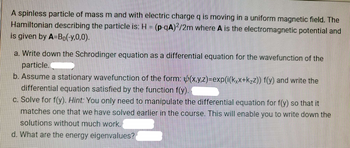Question

Transcribed Image Text:A spinless particle of mass m and with electric charge q is moving in a uniform magnetic field. The
Hamiltonian describing the particle is: H = (p-qA)2/2m where A is the electromagnetic potential and
is given by A-Bo(-y,0,0).
a. Write down the Schrodinger equation as a differential equation for the wavefunction of the
particle.
b. Assume a stationary wavefunction of the form: (x,y,z)=exp(i(kxx+k₂z)) f(y) and write the
differential equation satisfied by the function f(y).
c. Solve for f(y). Hint: You only need to manipulate the differential equation for f(y) so that it
matches one that we have solved earlier in the course. This will enable you to write down the
solutions without much work.
d. What are the energy eigenvalues?
Expert Solution
This question has been solved!
Explore an expertly crafted, step-by-step solution for a thorough understanding of key concepts.
This is a popular solution
Trending nowThis is a popular solution!
Step by stepSolved in 4 steps with 6 images

Knowledge Booster
Similar questions
- # quantum mechanical particde in a harmonic osci lator potential has the initial wave function y,)+4,(x), where Y. and Y, are the real wavefunctions in the ground and fist exci ted state of the harmonic osciclator Hamiltonian- for Convenience we take mzhzw= 1 for the oscillator- What ở the probabilpty den sity of finding the par ticke at x at time tza?arrow_forwardA neutron of mass m of energy E a,V(x) = Vo ) II. Estimate the kinetic energy of the neutron when they reach region III.arrow_forwardA qubit is in state |) = o|0) +₁|1) at time t = 0. It then evolves according to the Schrödinger equation with the Hamiltonian Ĥ defined by its action on the basis vectors: Ĥ0) = 0|0) and Ĥ|1) = E|1), where E is a constant with units of energy. a) Solve for the state of the qubit at time t. b) Find the probability to observe the qubit in state 0 at time t. Explain the result by referring to the way that the time-evolution transforms the Bloch sphere.arrow_forward